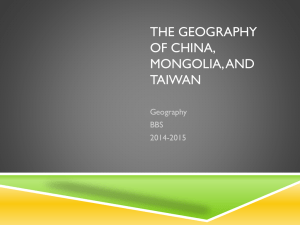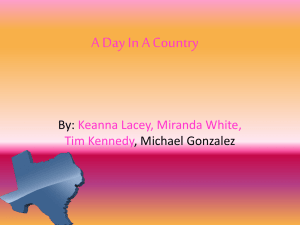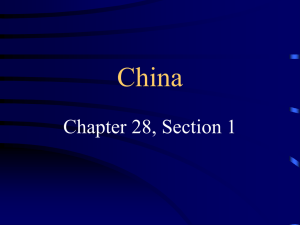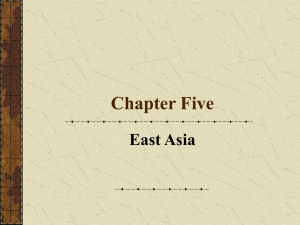World Geography East Asia Notes
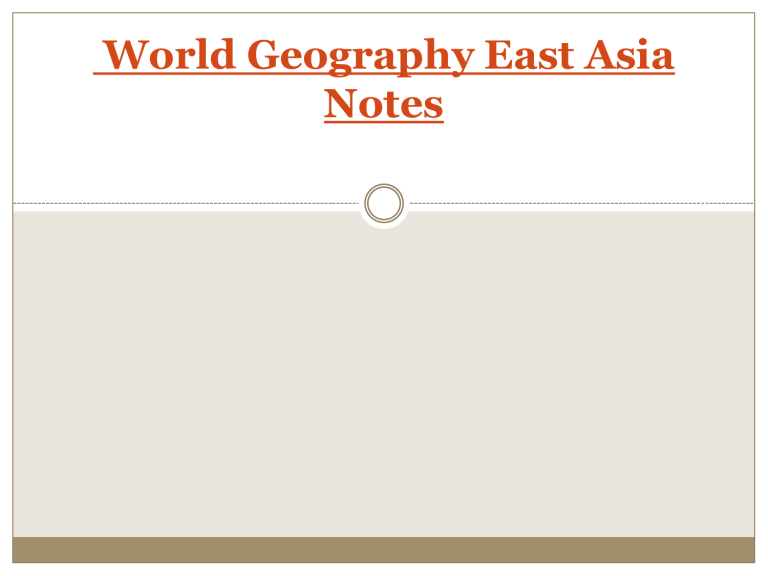
World Geography East Asia
Notes
Physical
Mainland
China occupies 81% of
East Asia
Also has the world’s largest population
Mongolia – size of Texas,
New Mexico, Arizona, and Colorado combined
Population of only
2,400,000
Peninsulas and Islands
Korean Peninsula
- North Korea – Communist
Government
- South Korea – Democratic
Government
Taiwan – Island that once belonged to mainland China, which still claims it today
Japan- small island nation with large economic power
Hong Kong – Chinese
Territory
- Hong Kong was Britain’s, but was returned to China’s control in 1997
Mountains
Himalayas – Located along the western border of
East Asia
- World’s highest mountains
Kunlun Mountains located in west China
- source of Huang He
(Yellow) and Chang Jiang
(Yangtze) rivers
Qinling Shandi
Mountains - divide northern China from the south
Rivers
Huang He (Yellow
River)—Located in northern China flows into the Yellow Sea
- Called Yellow River because it carries tons of loess ( yellowish brown topsoil)
Rivers
Chang Jiang(Yangtze
River) – Asia’s longest river
- Flows through China and empties into the East
China Sea
- major trade route, but floods often cause great damage
Japan and Korea have many short swift flowing rivers
Water Resources
China’s long river systems are important to its economy
- provide crop irrigation, hydroelectric power, transportation
Water Resources
Three Gorges Dam on
Chang Jiang will control floods & create power
(world’s biggest)
- Negative effectsare that one to two million people will have to move
- hundreds of historical sites
& factories will be submerged
(Water Pollution?)
- some species (alligator, river dolphin, others) may vanish
-Dam could cost $75 billion rather than original $11 billion estimated
Water Resources
Sea is important food source for East Asia
- Japan has one of world’s largest fishing industries
Resources of East Asia
East Asia is rich in Natural resources, but has uneven distribution
- China, Mongolia, North Korea have natural & mineral resources
- Japan, South Korea, Taiwan have limited natural resources
Forests -Abundant in China, Japan, Taiwan, North and
South Korea
- Japan reserves forests by buying timber from other regions
China has large petroleum, coal, natural gas reserves
(makes it self-sufficient)
Desert - Gobi Desert located in Mongolia is often cold and windy
Climates
Climates
Subarctic - Small subarctic zones on
Mongolia’s and China’s
Russian borders
Humid Continental northeastern China, northern Japan, North
Korea, & northern South
Korea
Humid Subtropical -
Southeastern China, southern South Korea, south Japan, north Taiwan
Climates
Tropical climate zone in East Asia is small
- strip of land along
China’s southeastern coast
- island of Hainan, southern tip of Taiwan
Typhoon—tropical storm that occurs in western Pacific
Climate Review Questions
Which East Asian country has the world’s largest population?
What type of landform is Taiwan?
What type of Landform are North & South Korea?
What are the world’s highest mountains & where are they located in relation to East Asia?
What is Asia’s longest River?
What river is also known as he Yellow River?
Where would you find a subarctic climate in East Asia?
On what river is the Three Gorges dam being built?
What are the positive effects that the Three Gorges dam will have on
China?
What are the negative effects the Three Gorges Dam will have on
China?
China
History
Oldest continuous civilization
- A settled society for 4,000 years
-Stone Age cultures later ruled by dynasties—series of family rulers
1200s - arrived Europeans
(Marco Polo)
1800s- European powers sought access to Chinese markets (Treaties)
1949 China became communist
- Mao Zedong ruled mainland People’s Republic
China’s Rural and Industrial Economies
China is largely rural society
& agriculturally self-sufficient
- river valleys have rich soil;
60% of workers on farms
Can only farm 13% of land due to mountains, deserts
- grows enough to feed population
The Industrial Economy industrial growth stunted under planned economy through 1970s
-1980s open marketplace created fast-growing economy
Culture
Chinese Inventions - Paper, printing, gunpowder, compass, porcelain, silk cloth
Confucianism – inspired by
Chinese philosopher Confucius
(551–479 B.C.)
- orderly, educated society has respect for past, ancestors
- children obey parents; parents obey government, emperor
Taoism—from Tao-te Ching book of Lao-tzu teachings (500s
B.C.)
- preserve, restore harmony in individual, universe
Indian Buddhism grew in
China & was influenced by
Confucianism & Taoism
China’s Population
One-fifth of world’s people live in China population is about 1.3 billion
Many of China’s 22 provinces are bigger than most countries
-70% of people live in 12 eastern provinces
Health Care
China has provided health care for huge populace since
1950
China has dual strategy in developing health-care system
People use traditional herbal remedies & acupuncture
Doctors use modern medicine, Western drugs & surgery
- most cities have hospitals
- village clinics have trained medical workers (“barefoot doctors”)
China Review Questions
What does Confucianism believe that all children should do?
What does Taoism believe is important?
What is a dynasty?
Who was the leader of Communist China until 1976?
Mongolia
History
Mongols were nomadic herders until Genghis
Khan conquered Central
Asia
1227 - Genghis Khan died & successors expanded empire
1300s - Empire broke up
History
1600s - China gained control of Mongolia
- 1911 - Mongolians achieved independence
1924 - Mongolia became
Communist
- remained Communist until 1989 (fall of
USSR)
Mongolia now moving toward democracy
Economic Prospects for Mongolia
Many people herd & manage livestock (sheep, goats, camels, horses, cattle)
- nomadic herding was economic base for centuries
- cashmere industry uses soft wool of local goats
Developing industries while making difficult shift to market economy
- Soviets guided economy for 70 years (state owned factories)
Daily Life in Mongolia
Nomads once guided animals from grassland to grassland
Nomads live in tents called yurts, made of felt, leather
- yurts are even found in capital of Ulaanbaatar
Many still raise sheep, cattle, goats; some are still nomadic
- most live on farms and ranches with small villages in center
Mongolia Review Questions
What do goats in Mongolia produce?
What is a yurt & in what East Asian country are they used?
Tawain
Taiwan’s Link to China
Prehistoric people migrated to Taiwan from
China, southeast Asia
1949 - Chinese
Nationalists lost to
Communists & fled to island
- established Republic of
China (not recognized by
China)
Taiwan’s Economic Success
Prosperity based on manufacturing industries and trade
Has few resources but trained, motivated workers
Taiwan, Singapore,
South Korea are
economic tigers nations with cheap labor, high technology, & aggressive exports
Taiwan’s Economic Success
Pacific Rim - economic, social region surrounding Pacific
Ocean
- East and Southeast
Asia, Australia, New
Zealand, Chile, U.S. coast
Taiwan’s Culture
Population and culture is almost exclusively
Chinese
- capital city of Taipei has
Buddhist temples,
Chinese art museums
Well-educated population: many universities, 30 daily newspapers
Taiwan’s Culture
Most speak official language of Northern
Chinese (Mandarin)
People combine a number of religious, ethical beliefs
- 90% practice blend of
Buddhism,
Confucianism, Taoism
Baseball is popular in
Taiwan, other parts of
Asia (especially Japan)
Taiwan Review Questions
What three things are needed in order for a country to become an economic tiger?
What is the Pacific Rim?
North & South Korea
Korea’s History
Manchurians& Chinese migrated to area by 2000 B.C.
Korea was often invaded by
China & Japan
1910 - Japan conquered Korea
& ruled until WWII defeat in
1945
After WWII, northern Korea is controlled by USSR, southern by U.S.
1950 - North Korean troops invaded South Korea & began
Korean War
-1953 treaty ended war & divided peninsula
Culture
Korea adopted many philosophical & religious ideas from China
- Confucian, Buddhist influences
Communism molds North
Korean culture
South Korea is influenced by Western culture
North Korean government only allows Communist or folk art
South Korean artists have more freedom of expression
Population Patterns
Most people live on coastal plains & river valleys
South Korea has 45% of peninsula’s land & 66% of population
Japan
Japan’s History
First people came from South
Pacific, or from Siberia
1853 - U.S. Commodore
Matthew Perry ended Japan’s isolation
By the early 20th century,
Japan is a major power
(Fought U.S in WWII)
Expanding empire put
Japan’s interests in conflict with U.S
After WWII - U.S. occupied
Japan & brought political & economic reforms
Japan became democracy
An Economic Powerhouse
Japan has world’s 2 nd largest economy
Japan imports resources to manufacture products for export
- exports autos, electronics, computers
Strong ties between business and government help economy
Japanese Culture
Chinese influence early language, religion, art, music, government
Japan has been open to
Western influences since
1800s
Popular sports are baseball, golf, sumo wrestling, soccer, tennis
Japanese Culture
Most clothes are
Western; traditional clothes for special occasions
Western music is popular, including rock, classical, & jazz
- younger Japanese form rock bands
Life in Today’s Japan
Highly structured educational system
- students in school six days a week; six weeks of summer vacation
- six years of elementary, three of junior high, three of high school
- Japan has more than 1,000 universities and technical schools
75% live in cities & 60% live on 2.7% of land
Life in Today’s Japan
Houses are small & sparsely furnished
Many people in cities live in apartments
- family of four in a one-bedroom apartment is common
Some move to suburbs, but must commute several hours to work
Coastal cities reclaim land with landfill landfill is solid waste buried in layers of dirt
- Tokyo puts factories, refineries on landfill
Physical Forces in the Ring of Fire
Many Japanese cities are threatened by earthquakes
- Japan is on the Ring of
Fire—chain of volcanoes around Pacific Rim
Subduction -oceanic plate slides under continental plate
Since first records, at least
60 Japanese volcanoes have been active
- Mt. Fuji, Japan’s bestknown landform is a volcano
Physical Forces in the Ring of Fire
Earthquakes and
Tsunamis - An average of
1,000 earthquakes occur in
Japan each year
- most are mild, but some cause many deaths, great destruction
1923 - Great Kanto
earthquake and its fires killed 140,000 people
- left Tokyo in ruins, damaged or destroyed
700,000 homes
Physical Forces in the Ring of Fire
Underwater earthquakes move ocean floor; can create tsunami
- huge wave of great destructive power that can reach over 100 feet
Industrialization and Globalization
Nations industrialized & East-
West trade increased after WWII
- “Made in China,” “Made in
Japan” labels are common in
West
Regional economies merged &, global economy developed
- global economy- nations are interdependent for goods & services
Economically powerful nations in
Pacific Rim zone of prosperity
- called the Jakota Triangle—
Japan, Korea (South), Taiwan
Economic Problems Arise
Asian economies run on efficiency, innovation, and cheap labor
1995 report from
UNICEF (the United
Nations Children’s
Fund)
- over 500,000 East
Asian children work in factories & beg on streets
Economic Problems Arise
Japan entered
recession—an extended decline in business activity
- Asian economic crisis spread through the world
World Bank lent money to
East Asian countries that promised reform
- ban on child-labor & forced-labor practices
- Ending the use of
sweatshops - places where people work long hours in poor conditions for pennies
Japan Review Questions
What percentage of Japanese people live in cities?
What is Japan’s best known landform?
What is the Ring of Fire?
What is subduction?
How are landfills created in Japan?
What is a recession?
What is a sweat shop?
What did the World Bank do & what was the stipulation behind its action?
What did a UNICEF report say that East Asian children were doing?
What is a global economy?
What happened during the Great Kanto Earthquake?
What is a Tsunami?
What is the Jakota Triangle?
What were shoguns?

